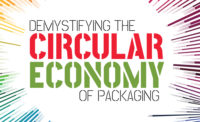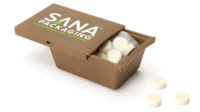It’s not a secret that the cannabis industry has a packaging waste problem. And unfortunately, there’s not a quick fix or silver bullet when it comes to sustainable packaging materials and our waste management infrastructure. A lot of sustainable packaging is about tradeoffs because all packaging has an impact on the environment. There are pros and cons to every packaging material. That said, some material types are clearly more detrimental to the environment than others.
When we talk about sustainable packaging, we’re looking at the whole picture and not focusing too narrowly on a singular aspect of a material type or the waste management system.
In order to truly solve the packaging waste problem, not just for cannabis but for all industries that rely on single-use packaging, we need a holistic approach that addresses both the packaging materials we use and the waste management infrastructure they interact with.
This is why we need to transition from a linear take-make-dispose economic model to a circular economic model. The Ellen MacArthur Foundation defines a circular economy as adhering to three guiding principles: (1) eliminating waste and pollution, (2) keeping products and materials in use and (3) regenerating our natural systems.
Transitioning to a circular economy is especially important for plastic, which is the most common polluter of the environment. While there are a variety of material types used for cannabis packaging — like glass, metal and paperboard — plastic is the most common material used for cannabis packaging.
Two major reasons plastic is the most common material type used for cannabis packaging involve product preservation and the strict cannabis packaging regulatory environment.
First, cannabis is a perishable product and plastic packaging extends the shelf-life of perishable products. Second, it’s challenging to design child-resistant locking mechanisms using sustainable materials. Every legal cannabis market requires some form of child-resistant packaging, whether it’s the primary product-touching layer of packaging or a secondary layer of packaging, like an exit bag.
Some states require cannabis packaging to be opaque while others do not, and others require specific wall thicknesses for cannabis packaging. These variations in cannabis packaging regulations make it difficult to use sustainable packaging materials.
A 2016 study by the World Economic Forum, the Ellen MacArthur Foundation and McKinsey & Company revealed that of the 78 million tonnes of plastic produced annually 40% goes to landfill, 32% escapes into the environment, 14% is incinerated and 14% is collected for recycling. These numbers are not encouraging and are a direct consequence of a linear economic model.
So what would a circular economy for plastics and cannabis packaging look like? In a circular economic model, materials are reused or recycled in closed-loop systems or have adequate end of lifecycle plans like anaerobic digestion or composting.
The Ellen MacArthur Foundation states that the vision for a circular economy for plastics has the following six key points, all of which can be directly applied to a circular economy for cannabis packaging:
The first point is the “elimination of problematic or unnecessary plastic packaging through redesign, innovation, and new delivery models.” There is a lot of unnecessary packaging in the cannabis industry and perhaps it’s time for the cannabis industry to revisit child-resistant packaging for non-activated products, like flower and pre-rolls.
It makes sense to use child-resistant packaging for activated products like edibles, but a recent study by McGill University suggests that getting rid of child-resistant packaging for non-activated products has the potential to reduce cannabis packaging waste by upwards of 70% along with increasing the recycling rate of cannabis packaging, increasing the range of packaging materials available to producers and reducing the cost of cannabis packaging.
The second point is reuse models should be “applied where relevant, reducing the need for single-use packaging.” Perhaps the best example of a circular packaging system is the “milkman model” employed in the 1950s, where milk bottles were collected and reused until they were no longer usable.
Coupled with recycling when the packaging is no longer usable, the “milkman model” could be an ideal solution for cannabis markets that allow point-of-sale packaging, like Colorado and Oregon. The current regulatory environment makes it extremely difficult to collect and reuse cannabis packaging but there are organizations trying to do this, like Green for Green in Colorado.
The third point is that all plastic packaging should be 100% reusable, recyclable or compostable. Most cannabis packaging is already reusable, recyclable or compostable on paper, but in practice is where this gets tricky, and that brings us to the next point.
The fourth point is that all plastic packaging should be “reused, recycled or composted in practice.” This is also a no-brainer, but unfortunately our recycling system is broken, our industrial composting system is virtually nonexistent and it’s incredibly difficult to collect and reuse cannabis packaging due to the strict regulatory environment.
To achieve recycling and composting packaging in practice — not just cannabis packaging but all packaging — we need to radically rethink our waste management system and update our crumbling waste management infrastructure. And to achieve reusing cannabis packaging in practice, we need to radically rethink cannabis packaging regulations.
The fifth point is that plastic use should be “fully decoupled from the consumption of finite resources.” This means drastically reducing the use of virgin petroleum-based resins and transitioning to biobased, reclaimed and recycled resins all single-use packaging.
This is exactly what Sana Packaging accomplishes: using plant-based, reclaimed and ocean-bound plastics for its cannabis packaging, with the ultimate goal of designing and developing cannabis packaging for a circular economy.
The sixth point is that all plastic should be “free of hazardous chemicals, and the health, safety and rights of all people involved are respected.” This is another no-brainer, but it should be noted that because cannabis isn’t federally legal yet, cannabis packaging is not subject to the same FDA requirements that govern other packaging verticals, like food and beverage packaging.
As a rapidly growing and emerging industry that is still developing its best practices, cannabis has a unique opportunity to do things right from the ground up and create a circular economic model for cannabis packaging.
Visit the Ellen MacArthur Foundation website to learn more about the circular economy and the future of packaging.




